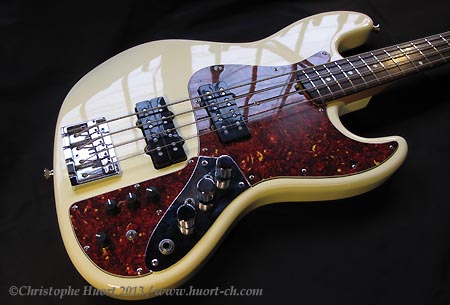Wiring & Electronics...
Atelkof Lutherie uses only RoHS compiliant parts assembled and welded with lead-free soldering wires (Pb free).
| |
Why leaving standard wirings?...
 |
|
|
|
||
 |
 |
|
Passive vs. Active... Cheese or desert?... And why not both?
|
 |
|
|
From single up to quad band circuits, and even more!... an overview of what's already available.
Overview
table of main options available to fit your project |
||||||||||
|
||||||||||
Ident. |
Details |
Nbr.
of bands |
Type
of bands, tuning frequencies and ranges |
Controls
panel layout |
||||||
Shelv. |
Graph. |
Param. |
Shift
sw. |
Main
characteristics |
Axis |
Stacked
pots |
Passive
tone |
|||
¬
Single band tone controls, SR-X1... series |
||||||||||
| SR-X1-PM | 1 |
Yes |
1 band semi-parametric with frequency shift, separates pots (2 axis), true bypass, switchable passive tone (optional) | 2 |
Option |
|||||
| SR-X1-PM/C | 1 |
Yes |
1 band semi-parametric with frequency shift, one axis concentric pot, true bypass, switchable passive tone | 1 |
Yes |
|||||
| SR-B1 | 1 |
- |
1 band, 1 pot, true bypass, works like a tue passive tone with active buffer ! | 1 |
Included |
|||||
¬
Dual band tone controls, SR-X2... series |
||||||||||
| SR-X2 | 2 |
- |
2 bands shelving shaped, 2 axis pots, true bypass, switchable passive tone (optional) | 2 |
Option |
|||||
| SR-X2/C | 2 |
- |
2 bands shelving shaped, concentric pots, true bypass, switchable passive tone | 1 |
Option |
|||||
| SR-X2-PM | 2 |
Option |
2 semi-parametric mid controls switchables separately, concentrics pots, true bypass, switchable passive tone (optional) | 2 |
Option |
|||||
¬
Triple band tone controls, SR-X3... series |
||||||||||
| SR-X3 | 3 |
- |
3 bands tone circuit, 3 axis separate pots, true bypass, switchable passive tone (optional) | 3 |
Option |
|||||
| SR-X3-PS | 3 |
Yes |
Same than SR-X3, but 3 frequencies mid switch, true bypass, switchable passive tone (optional) | 3 |
Option |
|||||
| SR-X3-PM | 3 |
Option |
3 bands, semi-parametric midrange, 4 axis saparate pots, true bypass, mid shift and switchable passive tone (optionals) | 4 |
Option |
|||||
| SR-X3-PM/C | 3 |
Option |
Idem SR-X3-PM, but concentric pots (2 axis), true bypass, mid shift and switchable passive tone (optionals) | 2 |
Option |
|||||
¬
Quad band tone controls, SR-X4... series |
||||||||||
| SR-X4 | 4 |
Option |
4 bands, 2 mids controls, 2, 3 or 4 axis configuration, true bypass, mid shift and switchable passive tone (optionals) | 4 |
Option |
|||||
| SR-X4-PM | 4 |
- |
Same than SR-X4, but with concentric pots (3 axis), true bypass, mid shift and switchable passive tone (optionals) | 3 |
Option |
|||||
¬
Custom made tone controls, SR-Xn... series |
||||||||||
| SR-Xn... | n |
- |
From 1 to 4 bands (and more!), modular system built upon demand... | n |
Option |
|||||
Retrofit circuits for vintage stuff...
Retrofit
examples for existing foreign models |
|
| Nota: The following items maybe retrofitted on many other instruments. The installs are possible only in our workshop. They are not available for fale separately. Fender®, Stratocaster®
, Telecaster®, Jazzmaster®, Jaguar®, and Bass VI®,
are registered trademark of Fender Musical Instruments Corporation.
|
|
| SJM-ROLLER / SVI-ROLLER : "Upper EQ" - Super VI/Super-JM module
|
|
 |
MX-PS : Three frequencies
|
| MM-X3P-RETR
|
|
| MM-X3X "Ultimate"
|
|
   |
|


